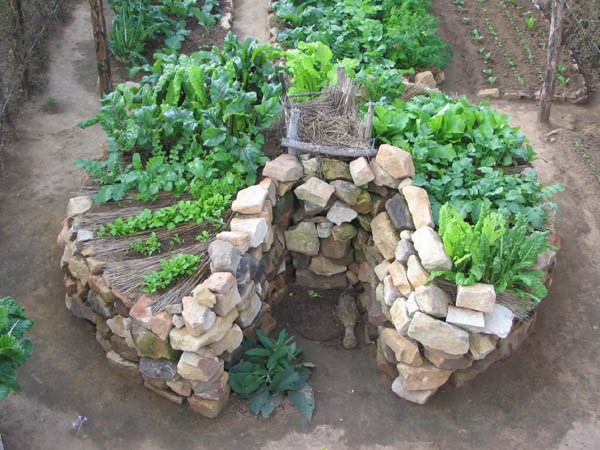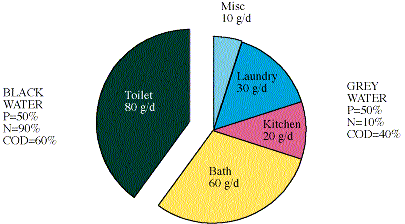Developed by the Send a Cow organization for citizens in Lesotho, Africa, keyhole gardens provide a great space for growing vegetables in such an unfavourable climate. They are circular in shape with a notch cut in, and are raised up to waist-height in order to allow the sick and elderly to tend to the crops without bending over. Manure and compost from the kitchen are placed in a basket of sticks and straw that rests in the middle. Rusty cans and ash are also placed within the soil, to give it iron and potassium, respectively. When water is poured in to the basket, nutrients are delivered to the plants.

1. Keyhole Garden in Lesotho
The soil in Lesotho has had all of the nutrients sucked out of it by massive farming operations, and droughts are not unheard of. The land is also very high above sea level, which adds even more frustration to the process of growing crops. Keyhole gardens ensure that the soil stays nutrient-rich, which allows crops to grow even when there is a water shortage.
One thing that I think is important to note is that the garden does not require purified water. Greywater is recommended because, although it has already been used once, it still is valuable. Greywater is wastewater that comes from activities such as washing the dishes, doing the laundry, and bathing.

2. Graph showing the breakdown of wastewater.
I assume that this pie chart is using statistics from a Westernized society, but it still shows the general idea that a majority of the water we use becomes greywater. This is actually good, because greywater is much easier to clean than blackwater. Some of the impurities in greywater also end up becoming food for the plants in a keyhole garden.
Clearly, the keyhole gardens are great for reusing the old to produce something new. This brings me to how it relates to the economy. The BBC did an article touching on these keyhole gardens in 2008, and interviewed Mahaha Mphou, a local citizen. They saw that, although she had nine other members in her family, she was able to produce excess food from her garden. The extra vegetables were sold to other citizens, and brought in a bit of an income to the previously poor family. The whole family helped tend it, and therefore they all saw the benefits.
Check out the videos below to see real footage and an animation on how one is built.
1. Making a Keyhole Garden
Image Sources:
1. "Keyhole Gardens," African Gardens, 2007. http://www.cowfiles.com/african-gardens/keyhole-gardens (accessed November 1, 2009).
2. "What it is, How to treat it, How to use it," Greywater, 2000. http://www.greywater.com/ (accessed November 2, 2009).
Video Sources:
1. "Lesotho - Make a Keyhole Garden," Making a Keyhole Garden, December 13 2007. http://www.sendacow.org.uk/makingakeyholegarden (accessed November 1, 2009).
Information Sources:
Rethabile. "What's a keyhole garden?," Black Looks, June 4, 2008. http://www.blacklooks.org/2008/06/whats_a_keyhole_garden.html (accessed November 1, 2009).
"Lesotho gardens relieve food crisis," BBC News, June 3, 2008. http://news.bbc.co.uk/2/hi/africa/7432972.stm (accessed November 1, 2009).
"Keyhole Gardens," AfriGadget, July 5, 2008. http://www.afrigadget.com/2008/07/05/keyhole-gardens/ (accessed November 1, 2009).
"What it is, How to treat it, How to use it," Greywater, 2000. http://www.greywater.com/ (accessed November 2, 2009).
-Alex Bodkin

1. Keyhole Garden in Lesotho
The soil in Lesotho has had all of the nutrients sucked out of it by massive farming operations, and droughts are not unheard of. The land is also very high above sea level, which adds even more frustration to the process of growing crops. Keyhole gardens ensure that the soil stays nutrient-rich, which allows crops to grow even when there is a water shortage.
One thing that I think is important to note is that the garden does not require purified water. Greywater is recommended because, although it has already been used once, it still is valuable. Greywater is wastewater that comes from activities such as washing the dishes, doing the laundry, and bathing.

2. Graph showing the breakdown of wastewater.
I assume that this pie chart is using statistics from a Westernized society, but it still shows the general idea that a majority of the water we use becomes greywater. This is actually good, because greywater is much easier to clean than blackwater. Some of the impurities in greywater also end up becoming food for the plants in a keyhole garden.
Clearly, the keyhole gardens are great for reusing the old to produce something new. This brings me to how it relates to the economy. The BBC did an article touching on these keyhole gardens in 2008, and interviewed Mahaha Mphou, a local citizen. They saw that, although she had nine other members in her family, she was able to produce excess food from her garden. The extra vegetables were sold to other citizens, and brought in a bit of an income to the previously poor family. The whole family helped tend it, and therefore they all saw the benefits.
Check out the videos below to see real footage and an animation on how one is built.
1. Making a Keyhole Garden
Image Sources:
1. "Keyhole Gardens," African Gardens, 2007. http://www.cowfiles.com/african-gardens/keyhole-gardens (accessed November 1, 2009).
2. "What it is, How to treat it, How to use it," Greywater, 2000. http://www.greywater.com/ (accessed November 2, 2009).
Video Sources:
1. "Lesotho - Make a Keyhole Garden," Making a Keyhole Garden, December 13 2007. http://www.sendacow.org.uk/makingakeyholegarden (accessed November 1, 2009).
Information Sources:
Rethabile. "What's a keyhole garden?," Black Looks, June 4, 2008. http://www.blacklooks.org/2008/06/whats_a_keyhole_garden.html (accessed November 1, 2009).
"Lesotho gardens relieve food crisis," BBC News, June 3, 2008. http://news.bbc.co.uk/2/hi/africa/7432972.stm (accessed November 1, 2009).
"Keyhole Gardens," AfriGadget, July 5, 2008. http://www.afrigadget.com/2008/07/05/keyhole-gardens/ (accessed November 1, 2009).
"What it is, How to treat it, How to use it," Greywater, 2000. http://www.greywater.com/ (accessed November 2, 2009).
-Alex Bodkin
No comments:
Post a Comment